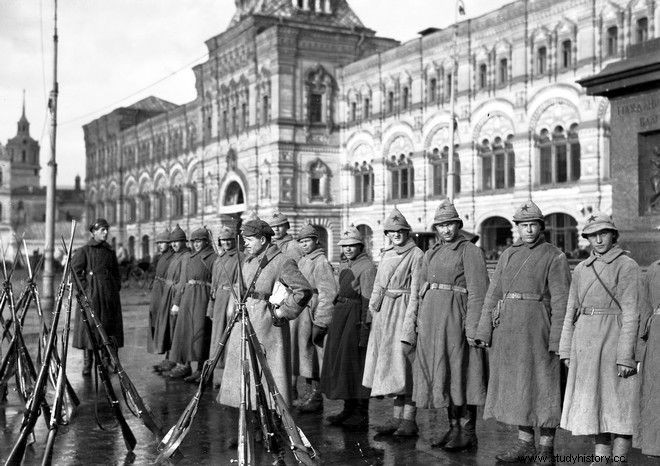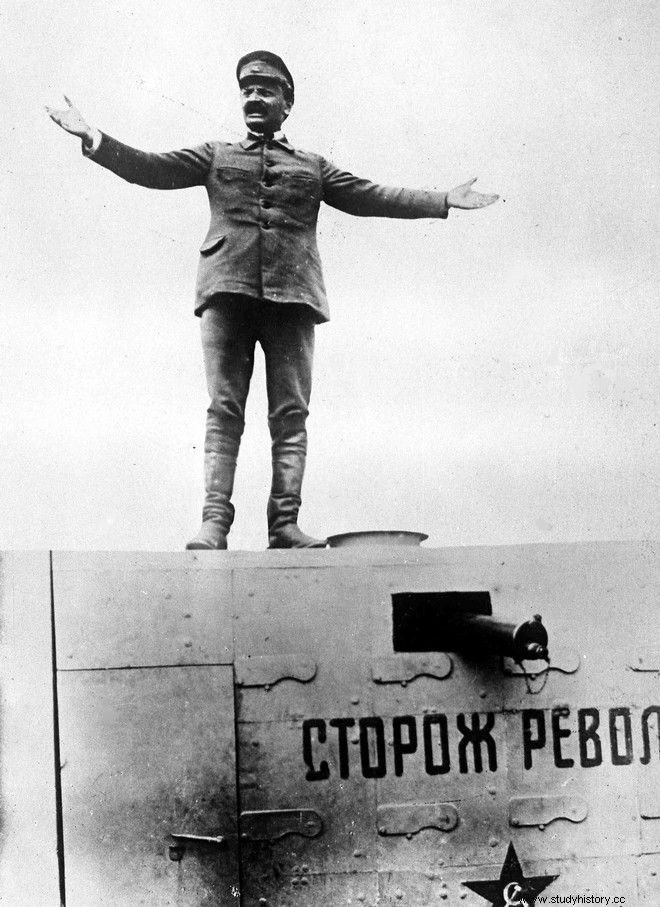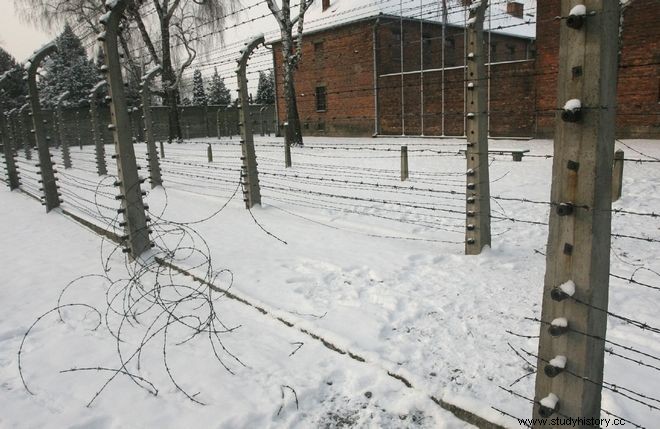It was January 28, 1918 when the Council of People's Commissars or Council of People's Commissars, known by the acronym Sovnarkom, decided to create the Red Army, which Kyriakos Mitsotakis, in a linguistic digression, named as "red", speaking yesterday in Auschwitz during the events of the 75th anniversary of the liberation of the horror camp.
"75 years after the liberation, by the Red Army, of this area, all of us should give this sacred commitment, never to forget what happened here," said the prime minister, among other things, causing reactions on social media.
The above statements were meanwhile accompanied by this ERT blunder:

The Red Army (Красная армия), was the army of Soviet Russia and later the Soviet Union. It was officially founded on February 21, 1918.
Among other things, he managed to repel the Wehrmacht at Stalingrad during World War II, which marked the beginning of the defeat of the Germans and liberated the Auschwitz-Birkenau Concentration Camp on January 27, 1945.
On 25 February 1946 the Red Army was renamed the Soviet Army (Советская Армия, Sovetskaya Armiya).

1. Leon Trotsky
's brainThe establishment of the Red Army followed a humiliating Russian defeat by the Germans in World War I. In 1917 German forces occupied large parts of the crumbling Tsarist empire. In December of the same year, representatives of the two sides met for peace negotiations in the small town of Brest-Litovsk, 180 km from Warsaw. The terms of the peace treaty finally signed there in March 1918 were extremely unfavorable to the fledgling Soviet Union, which was forced to cede much of its territory to the then German Empire – a humiliating treaty that should not be repeated.
Leon Trotsky began work in 1918 to form the Red Army, building it on the remnants of the tsarist army as he recruited several of his military commanders into the new force.
The red symbolized "the blood that has been shed in the battles against oppression".
Years later he declared himself satisfied with the result of his work:"The negligible percentage of illiterates among recruits is constantly decreasing," he pointed out in 1934. "Within and outside the army there is a rapid progress of all sports. During the last year they were distinguished only in Moscow 50,000 workers (…) as snipers".

For L. Trotsky the army was more than a military organization, as it was also "the school of the nation". The liquidation of the "Red Army" was carried out by Stalin who from 1937 gradually removed almost 35,000 officers.
Trotsky was expelled from the party in 1927 and in 1929 he was exiled to Alma Ata. In August 1940 he was assassinated by the Spanish Stalinist Ramon Mercander who had infiltrated his circle. He was one of the most capable, politically and theoretically, collaborators of Lenin and as the leader of the Red Army he had suppressed the Krostandi uprising.
The Decree on the Creation of the Red Army, elaborated by the Council of People's Commissars and signed by Lenin on January 15/28, 1918:
"THE DECREE ON THE CREATION OF THE RED ARMY
(JANUARY 28, 1918)
The old army served to oppress the working masses from the bourgeoisie. Since power has passed to the working masses and the oppressed, it is necessary to create a new army which will serve as a support for the power of the soviets and in the future as a basis for the replacement of the standing army by a national army, which will be the support of future social revolution in Europe.
I
For this reason the Council of People's Commissars decides the establishment of a new army to be called the Red Army of Workers and Peasants on the next base.
1. The red army of workers and peasants will consist of the most conscious and organized elements of the working classes.
2. All citizens of the Russian Republic over the age of 18 will be accepted into the Red Army. Every citizen who wants to join the Red Army must be ready to sacrifice all his strength, his life for the defense of the October Revolution, the power of the Soviets and Socialism. In order to become a member of the Red Army it is necessary to have the recommendation of the constitution committees or democratic organizations that accept the program of Soviet power, party or professional organizations or at least two members of these organizations. If groups of olakers join the red army, the soldiers must answer for each other and their admission will be submitted to the vote of all.
II
1. The soldiers of the Red Army of Workers and Peasants will be fully fed by the State and will receive 50 rubles a month.
2. The members of the soldiers' families, who are unable to work and who were supported before them, will receive what is necessary for them within the limits to be determined by the organs of power of the local soviets.
III
The highest governing body of the red army of workers and peasants will be the Council of People's Commissars. The direct command of the army will be concentrated in the military commissariat. Next to this, a national council will be established".
Source:Rizospastis (reprinted from the 11th issue (October 1932) of the magazine "NEW PIONEERS").
2. The Red Army liberates Auschwitz
From the beginning of 1945, on January 12, the "Vistula-Oder" operation of the Red Army began. The Soviet troops began their great advance towards the capital of Nazi Germany, Berlin.
The Germans, since November 1944, have been preparing to withdraw, unable to stop the advance of the Red Army. They began to tear down the buildings - witnesses of their atrocities. The crematoria and the four gas chambers were leveled. The incinerators were dismantled and prepared to be transported to the other concentration camp, Mauthausen, which they believed would not fall into Allied hands.
By January 18, the Germans had evacuated the Auschwitz camps as Soviet forces closed in on the complex, leading some 60,000 emaciated prisoners on death marches through the snow to the Bergen-Belsen concentration camp in the city of Bergen, and the city Vojislav Slaski in the western part of Upper Silesia, where survivors were loaded onto trains to the other concentration camps in Germany.
The SS shot anyone who stayed behind. More than 15,000 prisoners died on these death marches.

Two days later, on January 20, the Germans returned to the Auschwitz-Bickernau complex and blew up the last two crematoria, in an attempt to erase the traces of their heinous acts from the Soviets.
On Saturday, January 27, 1945, soldiers of the 60th Army of the 1st Ukrainian Front of the Red Army, a liberator enters Auschwitz, where he finds more than 7,000 abandoned prisoners, in a miserable condition, abandoned by the Nazis because they could not follow the march of death.
That morning the Soviet soldiers of the 322nd Infantry Division of the 60th Army, led by Red Army Colonel Pavel Kurochkin, entered the first camp, Auschwitz I, where they saw the first images of horror on the faces of the 1,200 survivors.
In the afternoon of the same day they entered Auschwitz II, the famous Bickernau camp, where they found 5,800 survivors, among them 611 children.
Of the 230,000 children in Auschwitz only 611 were released. The first accounts of the monstrous Nazi crimes committed by the German fascists were heard from the survivors of Auschwitz.
Of the more than 6 million people who died in the concentration camps created by the German fascists, more than 1.3 million were exterminated at Auschwitz. 900,000 were selected and executed in various ways, killed with poisonous gases in special gas chambers, hanged, shot, became test animals to ascertain resistance to various poisons. Over 200,000 died from disease, malnutrition and severe abuse and medical experiments. Of these approximately 1,100,000 were Jewish prisoners. Among them were 55,000 Greek Jews.
3. The flag in the Reichstag
"The red flag is flying in the Reichstag! Long live, Comrade Marshal!". The commander of the 3rd shock army, General V. I. Kuznetsov, who personally watched the historic battle to capture the Reichstag, announced the final victory to the command center and to Marshal Zhukov.
On April 30, 1945 at 21:50, Sergeant M. A. F. Yegorov and Sergeant M. V. Kantaria of the Soviet Army raised the red flag with the hammer and sickle, the Flag of Victory, over the central dome of the Reichstag. Nazi troops were still fighting inside Berlin, but this particular moment had its own symbolic significance.
Yevgeny Khaldei photographed the historic moment. His own frame, along with that of American soldiers nailing the flag on Iwo Jima (Associated Press), are the most characteristic of World War II. Khaldei's photo was first published on May 13, 1945 in Ogonyok magazine.
Vox.com had done a more thorough processing-analysis of the frame which is known to be the product of a director. According to the analysis you can see in the video below, the photo, titled "Raising a Flag over the Reichstag", has also been edited, decades before Photoshop was launched on the market.
Khaldei copied the smoke in the background from another photograph to make his frame more dramatic, while scraping the negative film with a needle, he erased one of the two watches worn by the soldier supporting the flag-bearer. He also changed the contrast to give more intensity to his photo. The watches were spoils of war.
The scene in the photo is actually a reenactment of an event that happened two days earlier, when 23-year-old Mikhail Minin placed the Soviet flag on the evening of April 30 on the famous peak. An event that was never captured on camera, while the flag was initially destroyed by Germans.
As Demosthenes Kurtovic writes in his book "Tetelestai", Khaldei had envisioned the composition of the photograph even before the Soviet troops occupied Berlin.
4. After World War II
As we wrote above, on February 25, 1946 the Red Army was renamed the Soviet Army (Советская Армия, Sovetskaya Armiya). After World War II the Red Army became the numerically strongest in the world. In addition, the number of his reserves reached 30 million men. The arsenal on German soil was also huge.
When the Red Army fully withdrew in 1994 from eastern Germany, it left behind a network of some 1,500 military installations.
A total of about half a million soldiers made their way back home. Germany also contributed financially to the transfer of military equipment from German territory, paying about 7.5 million marks (almost 4 million euros).
Large parts of this equipment are still in use today by the Russian armed forces.
The Soviet Army was replaced by the Russian Ground Army and was finally abolished on December 25, 1993.
5. When the historical parade of the Red Army was revived in 1941
Last year, on November 7, around 4,000 Russian soldiers took part in the parade held in Moscow's Red Square in honor of the November 7, 1941 parade, when Soviet soldiers marched to the front line to prevent the advance of Nazi troops. .
That historic 1941 parade took place on the same day as the anniversary of the October Revolution, but it played a big role in raising the morale of the army and the country, as in November 1941 Nazi troops were trying to enter Moscow, while the front line in some places it was within 30 kilometers of the Russian capital.
Early in the morning of November 7, 1941, in the Red Square of the besieged Moscow, the parade of the Red Army began.
28,400 soldiers participated in the parade, who, after parading, headed to the front line.
Invited to this anniversary parade were 1200 veterans of the Second World War (Great Patriotic War, as it is called in Russia).
